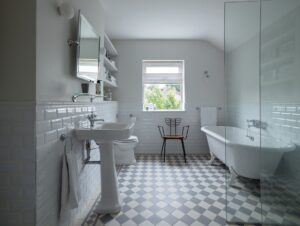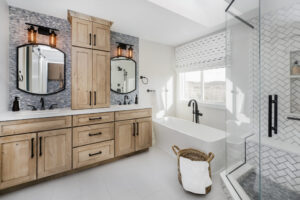Elevating Your Bathroom Design with a Floating Vanity: Style, Space, and Functionality

As Alex walked into the bathroom showroom, he had one goal: transforming his outdated bathroom into a sleek, modern space. He had spent weeks browsing design magazines and Instagram feeds, collecting inspiration for his envisioned minimalist oasis. One feature kept catching his eye—a floating bathroom vanity. Sleek, clean-lined, and effortlessly modern, these vanities made the bathrooms look more spacious and elegant while maintaining a functional edge. Alex had never considered his bathroom vanity anything more than a storage unit with a sink on top, but seeing the floating models changed everything. They didn’t just offer a place to wash up—they created a sense of openness and sophistication that grounded the entire room. Excited by the possibilities, Alex decided that a floating vanity would be the centerpiece of his renovation. As he quickly learned, these modern vanities aren’t just about aesthetics; they offer a blend of practicality, style, and space-saving benefits, making them a rising trend in bathroom design.
In recent years, floating bathroom vanities have become famous for homeowners looking to modernize their spaces. According to Houzz, the demand for floating vanities grew by 30% between 2020 and 2023, reflecting a shift toward minimalist and contemporary bathroom designs. In this article, we’ll explore the advantages of floating bathroom vanities, discuss design considerations, and look at the trends driving their popularity. Whether remodeling a small bathroom or upgrading a spacious main suite, a floating vanity could be the perfect solution to enhance your space aesthetically and functionally.
- What Is a Floating Bathroom Vanity?
Unlike traditional floor-mounted models, a floating bathroom vanity is mounted directly to the wall, making it appear “floating” above the floor. These vanities come in various styles, sizes, and materials, but they are most commonly associated with modern and minimalist designs due to their clean lines and open, airy appearance.
Depending on the design, floating vanities typically feature sleek cabinetry and countertops and can either have an open shelf beneath the sink for storage or no storage at all. One of the most significant selling points of floating vanities is their ability to make a bathroom feel more prominent, freeing up valuable floor space and creating a sense of openness. This is especially beneficial in small bathrooms or powder rooms where space is limited.
According to a 2023 report by NKBA (National Kitchen & Bath Association), the trend toward minimalist bathroom design, characterized by floating vanities, frameless mirrors, and open showers, continues to gain momentum. 41% of homeowners opt for floating vanities in their bathroom remodels.
- The Benefits of a Floating Bathroom Vanity
- Space-Saving Design
One of the primary reasons homeowners choose a floating vanity is the illusion of space it creates. Lifting the vanity off the floor makes the bathroom more open and less cluttered, making it an ideal choice for smaller bathrooms. Floating vanities offer the opportunity to play with the visual proportions of the room, creating the perception of a larger, more spacious environment.
For example, if you have a small bathroom with limited floor space, a floating vanity can make the room feel much more expansive by exposing more of the floor. It also allows easier cleaning since you can mop or vacuum underneath the vanity without obstruction.
A study by Architectural Digest found that small-space solutions, including floating vanities, were a top priority for 36% of homeowners renovating their bathrooms in 2023. Maximizing floor space without sacrificing style makes floating vanities popular for compact bathrooms or powder rooms.
- Modern Aesthetic
Another critical advantage of floating vanities is their sleek, modern appearance. They have become synonymous with contemporary bathroom design, aligning with the minimalist aesthetic currently trending. Floating vanities offer a streamlined look, eliminating the bulkiness of traditional vanities that sit directly on the floor.
With their clean lines and simplistic designs, floating vanities naturally fit modern bathrooms that prioritize form and function. They often feature materials like polished wood, concrete, or marble paired with matte black or brushed gold hardware to create a refined, contemporary look.
A survey by Houzz in 2022 revealed that 48% of homeowners remodeling their bathrooms were leaning toward contemporary or modern styles, with floating vanities playing a significant role in achieving that design vision. The emphasis on open spaces, minimal clutter, and elegant finishes has made floating vanities a top choice for those looking to update their bathrooms.
- Versatility in Design
While floating vanities are typically associated with modern design, they are versatile and can complement various styles, from industrial to Scandinavian or even rustic. Depending on the materials and finishes you choose, a floating vanity can either serve as the understated backdrop of the bathroom or as the statement piece that defines the space.
For example, a rustic wood floating vanity paired with a vessel sink and brass fixtures can create a warm, farmhouse-inspired bathroom, while a sleek white gloss floating vanity with a stone countertop can emphasize a minimalist, high-end spa-like experience. The flexibility in design makes floating vanities an attractive option for homeowners with different aesthetic preferences.
Furthermore, floating vanities are available in a wide range of sizes, so you can easily find one that suits your bathroom’s dimensions. Whether you’re designing a compact powder room or a luxurious master bath, there’s a floating vanity style to fit the space.
- Functional Considerations When Choosing a Floating Vanity
- Storage Solutions
While floating vanities are known for their sleek design, one common concern among homeowners is whether they offer enough storage. Because these vanities don’t extend to the floor, they typically have less storage capacity than traditional floor-mounted models. However, many floating vanities come with drawers, shelves, or cabinets that provide practical storage solutions for bathroom essentials.
If storage is a priority, consider choosing a floating vanity with built-in drawers or baskets to organize toiletries, towels, and cleaning supplies. Some designs even feature hidden compartments, maximizing the available storage space without compromising the minimalist look.
A Home & Garden study found that 27% of homeowners renovating their bathrooms were focused on incorporating intelligent storage solutions into their vanities, including pull-out drawers and hidden shelving. Floating vanities with clever storage options offer style and practicality, making them an excellent choice for busy households.
- Weight and Installation
When considering a floating vanity, consider the unit’s weight and the installation process. Because floating vanities are mounted to the wall, they require sturdy wall studs and secure installation to ensure they remain safely anchored.
Professional installation is often recommended for heavier vanities, such as those made from solid wood or stone countertops, to avoid any risk of damage or improper mounting. In contrast, lightweight materials such as plywood or laminate can be easier to install, though you should still ensure that the vanity is securely fastened to the wall.
According to Bob Vila, weight capacity is one of the leading concerns among homeowners installing floating vanities. Be sure to consult with a contractor or a professional installer to ensure your walls can support the weight of the vanity and any items you plan to store within it.
- Floating Vanity Trends for 2024
As the demand for floating vanities continues to rise, several design trends have emerged that highlight the creative possibilities of these modern fixtures.
- Integrated Lighting
One trend that has gained popularity is integrating LED lighting beneath floating vanities. This creates a soft glow that enhances the floating effect, making the vanity appear as though it’s hovering in the bathroom. Integrated lighting adds an extra layer of ambiance and luxury, especially in modern bathrooms with minimalist designs.
- Open Shelving
Another trend is the use of open shelving beneath the vanity. This design choice combines the sleek, floating look with practical storage solutions, allowing homeowners to display decorative items, baskets, or rolled towels. Open shelving can make the vanity feel more approachable and customizable, adding a personal touch to the space.
- Mixed Materials
In 2024, we’re seeing a growing interest in floating vanities incorporating mixed materials, such as wood and stone, metal and glass, or even concrete and brass. This trend allows homeowners to create a custom look that blends industrial elements with natural textures, resulting in a unique and modern bathroom design.
Conclusion
Floating bathroom vanities have become famous for homeowners looking to update their bathrooms with a sleek, modern, and functional design. Whether you’re working with a small powder room or a spacious master bath, these vanities offer a variety of benefits, from creating the illusion of space to adding a contemporary edge to your home.
With their growing popularity in the home renovation market, floating vanities offer a wide range of options in terms of style, material, and size. Whether you prefer a minimalist look with clean lines or a more rustic approach with natural wood finishes, a floating vanity can suit your needs. As homeowners continue to embrace modern bathroom design trends, it’s clear that floating vanities are here to stay.






